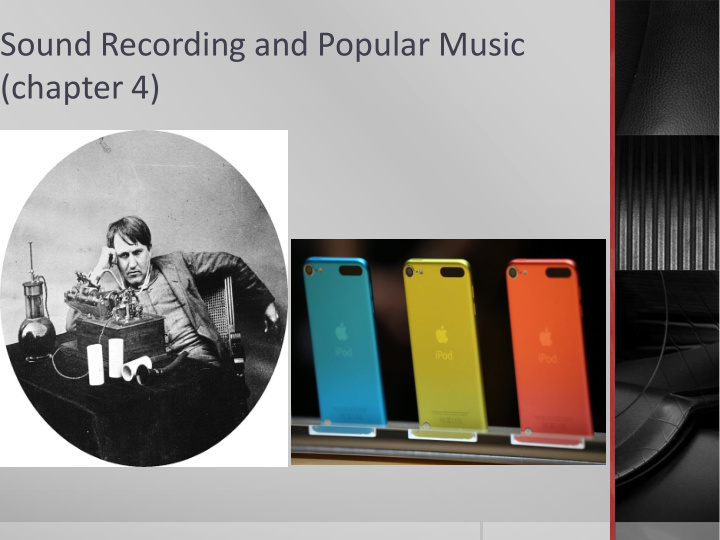



Sound Recording and Popular Music (chapter 4)
The medium of sound recording has Throughout its history, popular had an immense impact on our music has been banned by parents, culture. The music that helps to business outlets, radio stations, shape our identities and comfort us school officials, and even during the transition from childhood governments seeking to protect to adulthood resonates throughout young people from the raw our lives. It stirs debate among language and corrupting excesses parents and teenagers, teachers and of the music world. students, politicians and performers. “If people knew what this stuff was about, we’d probably all get arrested.” – Bob Dylan, 1966, talking about rock and roll “Music should never be harmless.” – Robbie Robertson, The Band
U.S. Popular Music and the Formation of Rock In general, pop music appeals either to a wide cross section of the public or to sizable subdivisions within the larger public based on age, region, or ethnic background (for example, teenagers, southerners, Mexican Americans). U.S. popular music today encompasses styles as diverse as blues, country, Tejano, salsa, jazz, rock, reggae, punk, hip-hop, and electronica.
Rock and Roll Is Here to Stay The cultural storm called rock and Many social, cultural, economic, roll hit in the 1950s. and political factors contributed to the growth of rock and roll around (Like the early meaning of jazz, rock the 1940s and 1950s. and roll was a blues slang term that sometimes meant “sex.”) The migration of southern blacks It combined the vocal and to northern cities in search of instrumental traditions of popular better jobs during the first half of music with the rhythm-and-blues the twentieth century had helped sounds of Memphis and the spread different popular music country beat of Nashville. styles.
Youth Culture Cements Rock’s Place Perhaps most significant to the Another reason for the growth of growth of rock and roll, the border rock and roll can be found in the that had separated white and black repressive and uneasy cultures began to break down. atmosphere of the 1950s. With the constant concern over the atomic bomb, the Cold War, and Radio, which saw its network communist witch-hunts, young programs converting to television, people were seeking forms of was seeking inexpensive forms of escape from the menacing world content. Radio deejays, particularly created by adults. Alan Freed in Cleveland (and later on WINS in New York), began exposing more white people to black music. Some white teens cruising the radio dial had already discovered black- oriented stations, however, and had adopted the different rhythms as dance music.
Rock ‘N’ Roll explodes
A Changing Industry: Reformations in Popular Music The British Are Coming! Motor City Music: Detroit Gives America Soul Popular Music Reflects the Times Alternative Sounds of Punk and Grunge Hip-Hop Redraws Musical Lines
The British Are Coming! Until 1964, rock-and-roll recordings had traveled on a one-way ticket to Europe This changed almost overnight. In 1964, the Beatles invaded with their mop-top haircuts and pop reinterpretations of American blues and rock and roll. By the end of the year, more than thirty British hits had landed on American Top 10 lists.
Britain Invades
Motor City Music: Detroit Gives America Soul soul: music that mixes These Motown groups had gospel, blues, and urban and a more stylized, softer southern black styles with sound than the grittier slower, more emotional, and southern soul (or funk) of melancholic lyrics. Brown and Pickett. Motown producers realized at the outset that by cultivating romance and dance over rebellion and politics, black music could attract a young, white audience.
Sounds of Soul
Popular Music Reflects the Times Folk Inspires Protest Bob Dylan took his stage name from Welsh poet Dylan Thomas. He led a folk music movement in the early 1960s with engaging, socially provocative lyrics.
My Generation
Rock Becomes Mainstream Following the historic Woodstock concert in August 1969, which drew more than 400,000 fans to a New York farm, the deaths of Joplin and Hendrix in 1970, and the announcement late in 1970 that the Beatles had officially disbanded, rock music reached a crossroads. Considered a major part of the rebel counterculture in the 1960s (despite its profits), rock music in the 1970s, was increasingly viewed as the centerpiece of mainstream consumer culture. With major music acts earning huge profits, rock soon became another product line for manufacturers and retailers to promote, package, and sell.
Up from the Underground
Hip-Hop Redraws Musical Lines Hip-hop exploded as a popular genre . in 1986 with the commercial successes of groups like Run-DMC, the Fat Boys, and LL Cool J. Because most major labels and many black radio stations rejected the rawness of hip-hop, the music spawned hundreds of new independent labels
Up from the Underground
Hip-hop, like punk, defies Throughout hip- hop’s history, mainstream culture. artists have occasionally characterized themselves as Some rap has drawn criticism from street reporters who tell both the white and black alternative stories of city life. communities for lyrics that degrade women or applaud . violence. Chuck D of Public Enemy has maintained that most hip-hop music offers interpretations of urban experience and the war on drugs that are very different from network news portrayals
Up from the Underground
Recommend
More recommend